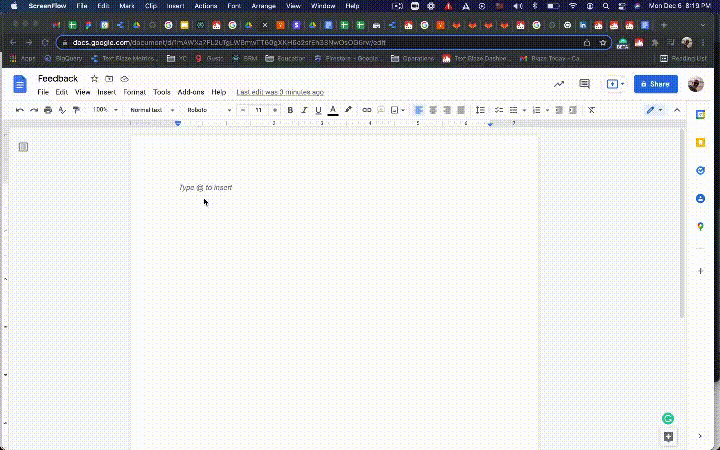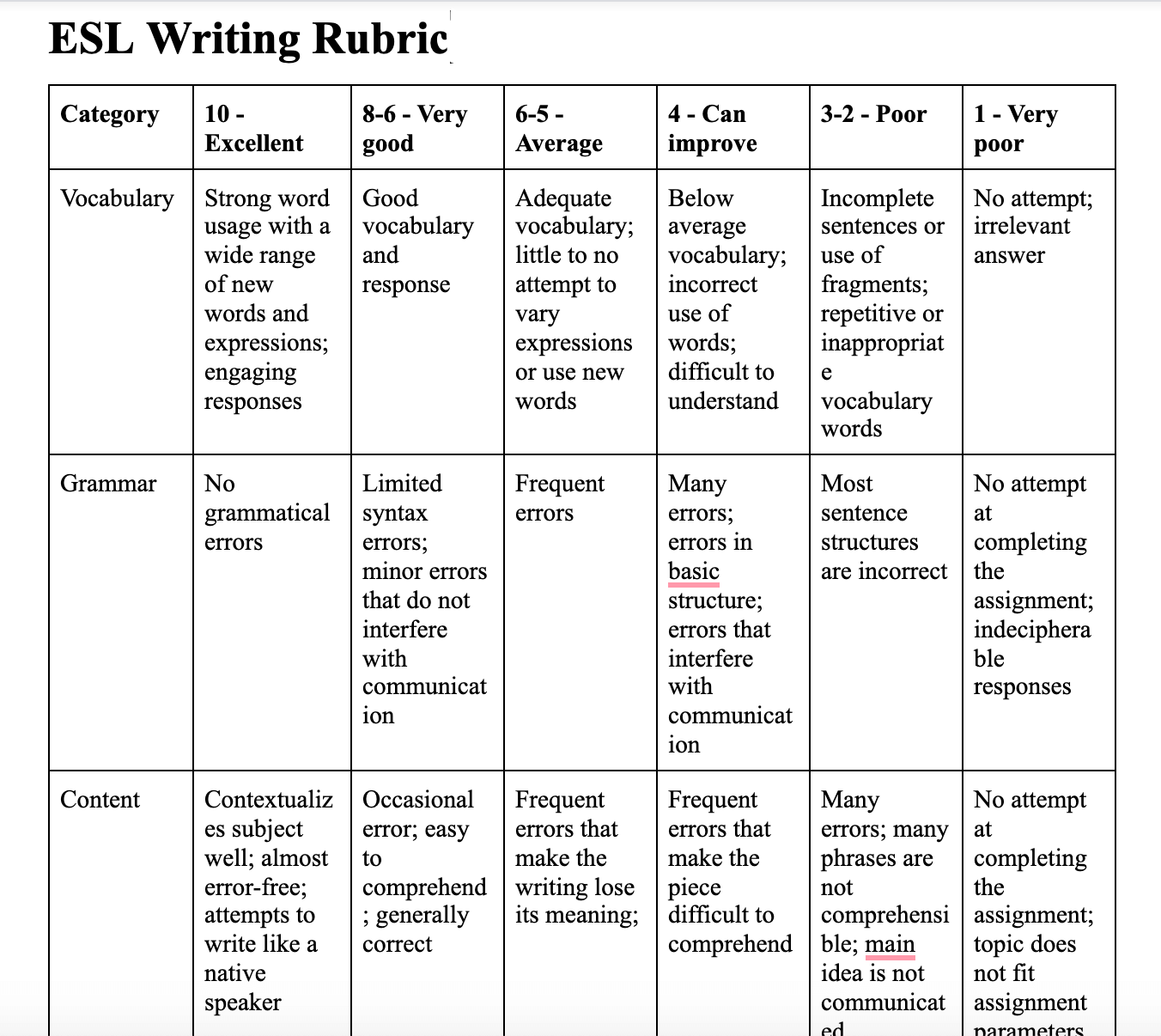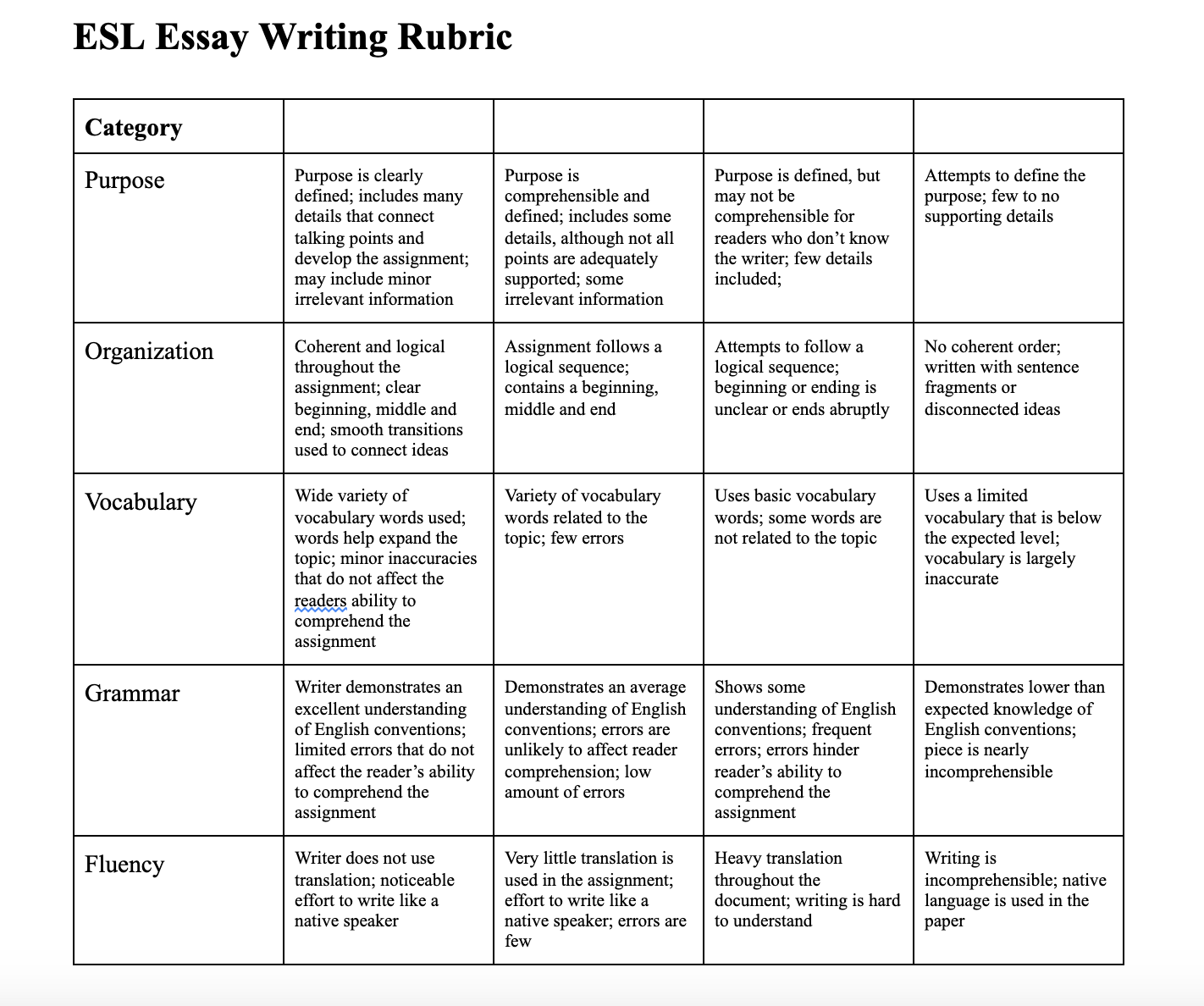Two ESL Writing Rubric Templates
Two ESL writing rubric templates that you can use to grade your student’s writing submissions.
Two ESL Writing Rubric Templates
Providing timely and high-quality feedback to students is key to ensure they make consistent progress, but grading (English as a Second Language) ESL writing assignments is time-consuming. An ESL writing rubric can make the process significantly easier for you and transparent for your students.

In this blog post, we will show you two ESL writing rubric templates that you can use to grade your student’s writing. But first, let’s understand what is an ESL writing rubric.
Join thousands of teachers who are working smarter
What is an ESL Writing Rubric?
Grading written essays objectively and consistently is difficult without standardized rubrics. With an ESL writing feedback rubric teachers can provide detailed, personalized, fair and unbiased feedback to their students.
Rubric-based feedback is helpful for students because it clearly communicates their instructor's expectations and how they measure against it, so don’t forget to craft a rubric that very clearly captures expectations and your feedback for the assignment.
ESL Writing Rubric Template

Vocabulary {formtoggle: name=wide vocab; default=no}Strong word usage with a wide range of new words and expressions; engaging responses.{endformtoggle: trim=yes} {formtoggle: name=Good vocab; default=no}Good vocabulary and response.{endformtoggle: trim=yes} {formtoggle: name=Adequate vocab; default=no}Adequate vocabulary; little to no attempt to vary expressions or use new words.{endformtoggle: trim=yes} {formtoggle: name=low vocab; default=no}Below average vocabulary; incorrect use of words; difficult to understand.{endformtoggle: trim=yes} {formtoggle: name=incomplete sentences; default=no}Incomplete sentences or use of fragments; repetitive or inappropriate word usage.{endformtoggle: trim=yes} {formtoggle: name=irrelevant; default=no}No attempt; irrelevant answer.{endformtoggle}
Vocabulary Score: {formmenu: 1; 2; default=3; 4; 5; 6; 7; 8; 9; 10; name=vocabulary}/10
Grammar {formtoggle: name=perfect; default=no}No grammatical errors.{endformtoggle: trim=yes} {formtoggle: name=minor errors; default=no}Limited syntax errors; minor errors that do not interfere with communication.{endformtoggle: trim=yes} {formtoggle: name=frequent errors; default=no}Frequent errors.{endformtoggle: trim=yes} {formtoggle: name=a lot of errors; default=no}Many errors; errors in the basic structure; errors that interfere with communication.{endformtoggle: trim=yes} {formtoggle: name=errors, not understandable; default=no}Most sentence structures are incorrect; frequent use of infinitives with little to no use of conjugations; not understandable unless the reader has experience with the writer. {endformtoggle: trim=yes} {formtoggle: name=poorly done; default=no}No attempt at completing the assignment; indecipherable responses.{endformtoggle}
Grammar Score: {formmenu: 1; 2; 3; 4; 5; 6; 7; 8; default=9; 10; name=grammar}/10
Content {formtoggle: name=error-free; default=no}Contextualizes subject well; almost error-free; attempts to write like a native speaker.{endformtoggle: trim=yes} {formtoggle: name=occasional errors; default=no}Occasional errors; easy to comprehend; generally correct.{endformtoggle: trim=yes} {formtoggle: name=frequent errors; default=no}Frequent errors that make the writing lose its meaning; the reader needs to guess what they’re reading about; hard to follow; possible use of an online translator.{endformtoggle: trim=yes} {formtoggle: name=difficult to comprehend; default=no}Frequent errors that make the piece difficult to comprehend.{endformtoggle: trim=yes} {formtoggle: name=incomprehensible; default=no}Many errors; many phrases are not comprehensible; the main idea is not communicated.{endformtoggle: trim=yes} {formtoggle: name=poorly done; default=no}No attempt at completing the assignment; topic does not fit assignment parameters.{endformtoggle}
Content Score: {formmenu: 1; 2; default=3; 4; 5; 6; 7; 8; 9; 10; name=content}/10
Voice {formtoggle: name=excellent; default=no}The writer’s distinct voice comes through in their writing; words are used correctly to emphasize points.{endformtoggle: trim=yes} {formtoggle: name=good; default=no}The writer’s voice sometimes comes through in the assignment; the intended audience is understood.{endformtoggle: trim=yes} {formtoggle: name=average voice; default=no}The writer delivers an average voice in the assignment with a general understanding of the audience.{endformtoggle: trim=yes} {formtoggle: name=weak voice; default=no}A weak voice throughout the assignment; vague to little understanding of the audience.{endformtoggle: trim=yes} {formtoggle: name=no voice; default=no}No voice in the assignment; little effort to understand the audience.{endformtoggle: trim=yes} {formtoggle: name=incomplete; default=no}No attempt to complete the assignment.{endformtoggle}
Voice Score: {formmenu: 1; 2; 3; 4; default=5; 6; 7; 8; 9; 10; name=voice}/10
Coherency {formtoggle: name=excellent; default=no}Smooth flow; excellent use of transitions; proper punctuation.{endformtoggle: trim=yes} {formtoggle: name=good; default=no}An effort to use transitions; flows well; all clauses used in the correct context.{endformtoggle: trim=yes} {formtoggle: name=choppy; default=no}Choppy; obviously translated but still comprehensible.{endformtoggle: trim=yes} {formtoggle: name=redundant; default=no}Redundant use of information; the language used is well below the expected level.{endformtoggle: trim=yes} {formtoggle: name=unrelated; default=no}Wrong phrases; isolated words; uses unrelated vocabulary.{endformtoggle: trim=yes} {formtoggle: name=poorly done; default=no}Incomprehensible; no effort.{endformtoggle}
Paper Organization Score: {formmenu: 1; 2; 3; 4; default=5; 6; 7; 8; 9; 10; name=organization}/10
Quality {formtoggle: name=clear; default=no}Confident and focused writing that holds the audience’s attention with relevant details.{endformtoggle: trim=yes} {formtoggle: name=focused, relevant; default=no}Focused writing with some relevant details.{endformtoggle: trim=yes} {formtoggle: name=quality, but limited; default=no}Quality writing with limited details.{endformtoggle: trim=yes} {formtoggle: name=incomprehensible, no details; default=no}Writing is incomprehensible; no details.{endformtoggle: trim=yes} {formtoggle: name=limited; default=no}Limited writing that does not adequately express or develop ideas. {endformtoggle: trim=yes} {formtoggle: name=poor; default=no}Limited writing with no clear focus or theme; No attempt at completing the assignment.{endformtoggle}
Quality Score: {formmenu: name=quality; 1; 2; 3; 4; 5; default=6; 7; 8; 9; 10}/10
Your writing score is {=quality+organization+voice+content+grammar+vocabulary}.
ESL Essay Writing Rubric Template

Thank you for submitting your assignment. You can read my feedback below:
Purpose
{formtoggle: name=Clearly defined; default=yes}Purpose is clearly defined; includes many details that connect talking points and develop the assignment; may include minor irrelevant information.{endformtoggle: trim=yes}
{formtoggle: name=good, not well supported; default=no}Purpose is comprehensible and defined; includes some details, although not all points are adequately supported; some irrelevant information.{endformtoggle: trim=yes}
{formtoggle: name=not comprehensible, loose connections; default=no}Purpose is defined, but may not be comprehensible for readers who don’t know the writer; few details included; loose connections; a lot of irrelevant information.{endformtoggle: trim=yes}{formtoggle: name=no supporting details; default=no}Attempts to define the purpose; few to no supporting details.{endformtoggle}
Organization
{formtoggle: name=coherent and logical; default=yes}Coherent and logical throughout the assignment; clear beginning, middle and end; smooth transitions used to connect ideas.{endformtoggle: trim=yes}
{formtoggle: name=follows a logical sequence; default=no}Assignment follows a logical sequence; contains a beginning, middle and end.{endformtoggle: trim=yes}
{formtoggle: name=beginning or end is unclear; default=no}Attempts to follow a logical sequence; beginning or ending is unclear or ends abruptly.{endformtoggle: trim=yes}
{formtoggle: name=incoherent, disconnected ideas; default=no}No coherent order; written with sentence fragments or disconnected ideas.{endformtoggle}
Vocabulary
{formtoggle: name=wide vocab; default=yes}Wide variety of vocabulary used; words help expand the topic; minor inaccuracies that do not affect the reader's ability to comprehend the assignment.{endformtoggle: trim=yes}
{formtoggle: name=good vocab, few errors; default=no}Variety of words related to the topic; few errors.{endformtoggle: trim=yes}
{formtoggle: name=basic vocab, unrelated words; default=no}Uses basic vocabulary; some words are not related to the topic.{endformtoggle: trim=yes}
{formtoggle: name=limited vocab, very inaccurate; default=no}Uses a limited vocabulary that is below the expected level; vocabulary is largely inaccurate.{endformtoggle}
Grammar/Punctuation/Conventions
{formtoggle: name=excellent; default=yes}The writer demonstrates an excellent understanding of English conventions; limited errors that do not affect the reader’s ability to comprehend the assignment.{endformtoggle: trim=yes}
{formtoggle: name=average; default=no}Demonstrates an average understanding of English conventions; errors are unlikely to affect reader comprehension; low amount of errors.{endformtoggle: trim=yes}
{formtoggle: name=frequent errors; default=no}Shows some understanding of English conventions; frequent errors; errors hinder reader’s ability to comprehend the assignment.{endformtoggle: trim=yes}
{formtoggle: name=incomprehensible; default=no}Demonstrates lower than expected knowledge of English conventions; the piece is nearly incomprehensible.{endformtoggle}
Fluency {formtoggle: name=noticeable effort to write; default=yes}The writer does not use translation; puts noticeable effort to write like a native speaker.{endformtoggle: trim=yes} {formtoggle: name=very few errors; default=no}Very little translation is used in the assignment; effort to write like a native speaker; errors are few.{endformtoggle: trim=yes} {formtoggle: name=hard to understand; default=no}Heavy translation throughout the document; writing is hard to understand.{endformtoggle: trim=yes} {formtoggle: name=incomprehensible; default=no}Writing is incomprehensible.{endformtoggle}


